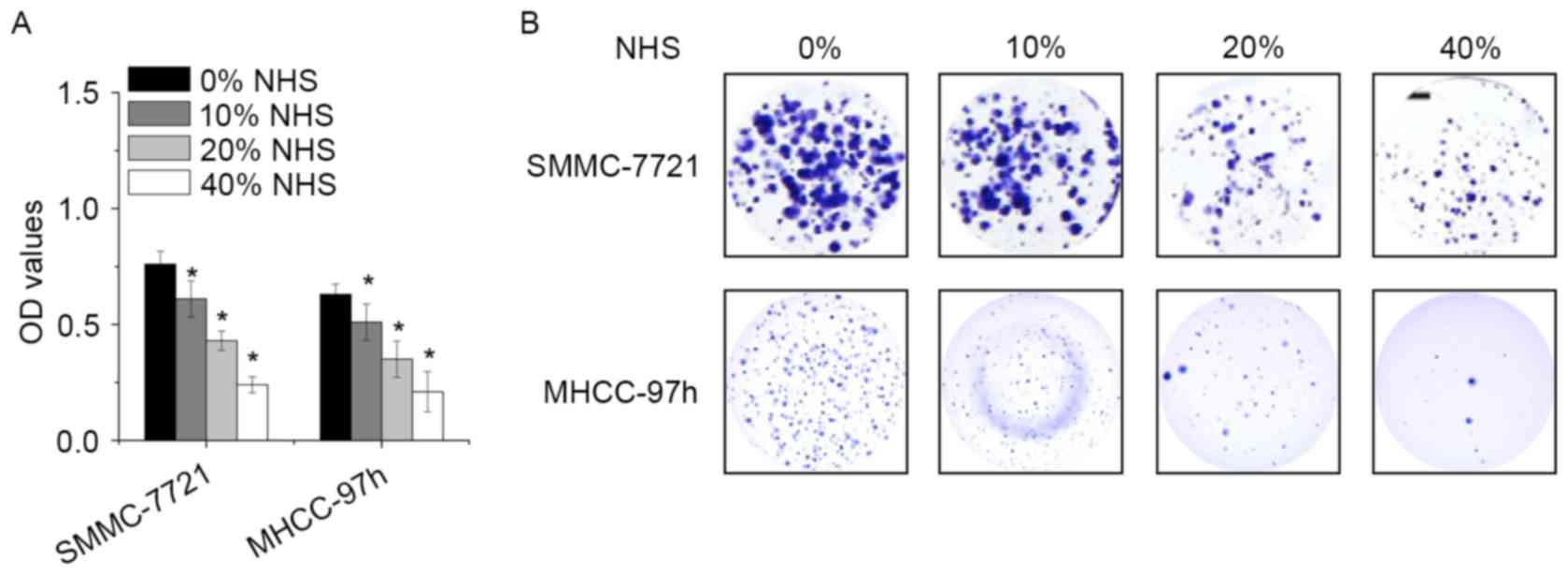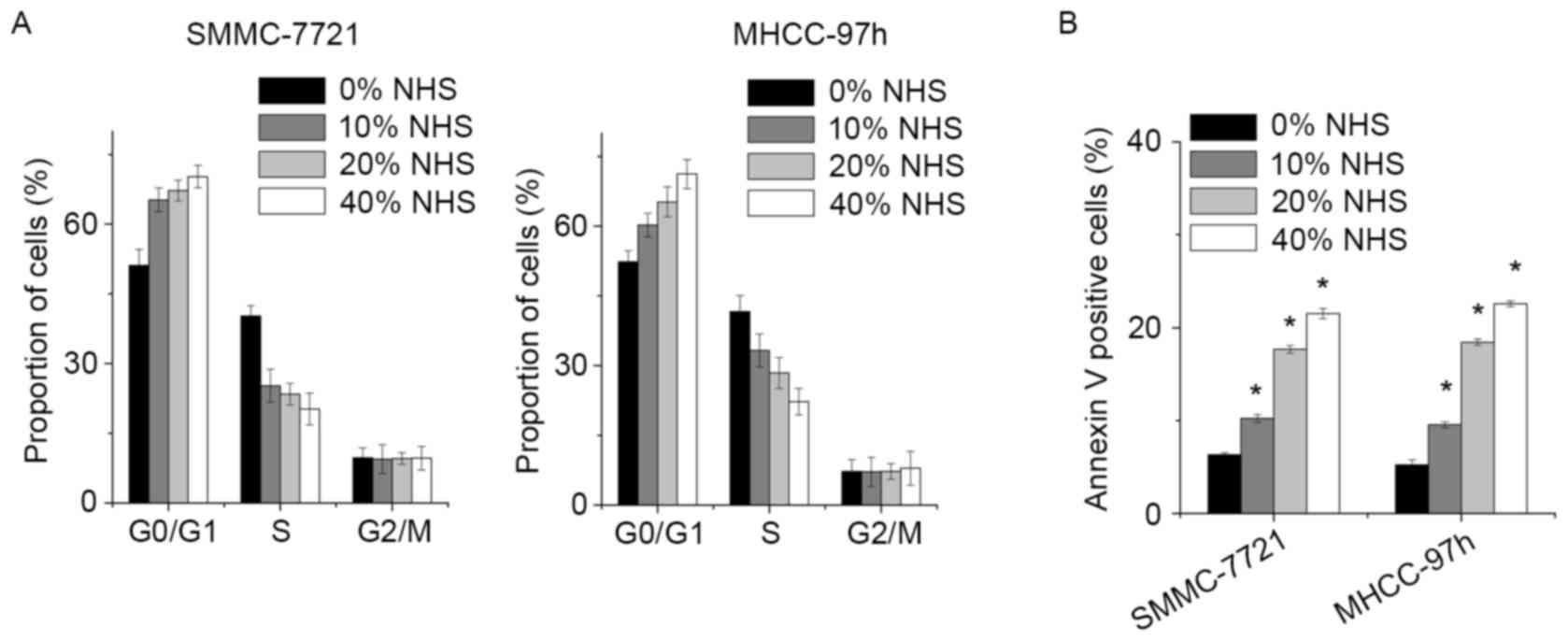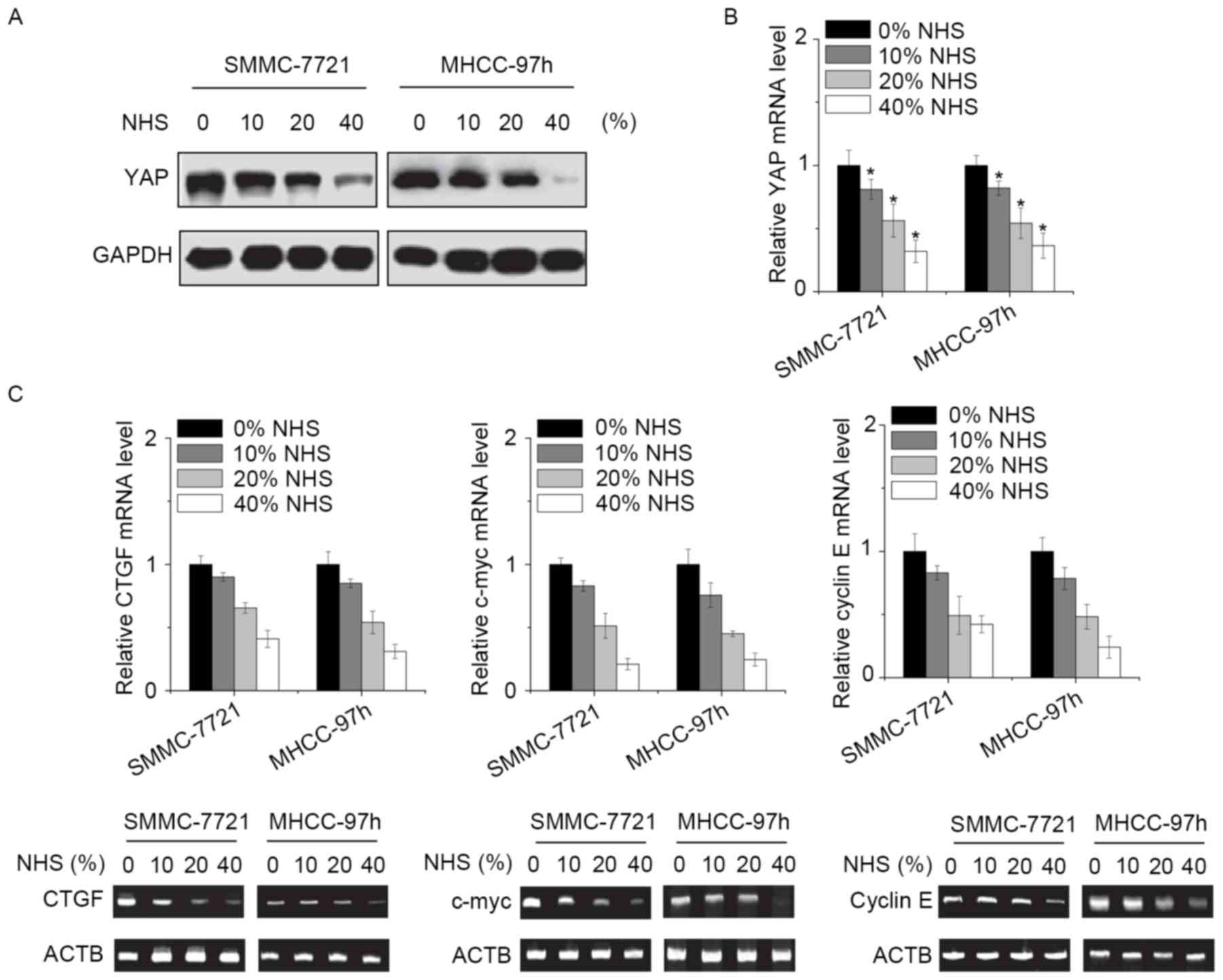Niu‑Huang‑Shen suppresses hepatocellular carcinoma cell growth and metastasis by regulating Yap1 expression
- Authors:
- Published online on: October 2, 2017 https://doi.org/10.3892/etm.2017.5247
- Pages: 5459-5463
-
Copyright: © Peng et al. This is an open access article distributed under the terms of Creative Commons Attribution License.
Abstract
Introduction
Hepatocellular carcinoma (HCC) is one of the most common cancers types, which is the third leading cause of cancer-associated death worldwide (1). Surgery is the primary therapy for early-stage HCC, but metastasis and recurrence rates remain high at five years post-surgery. In spite of the progress regarding the therapeutic options for advanced HCC, the prognosis of HCC patients remains poor (2). Research on drugs with antitumor activity may lead to the development of novel chemotherapeutic agents.
Niu-Huang-Shen (NHS), a modern Chinese medicine, is prepared from cholic acid, hyodeoxycholic acid, baicalin and five other medicinal materials (3,4). A previous study revealed that NHS has a wide pharmacological spectrum, exerting antipyretic, anti-inflammatory and vasodilation effects (5). However, whether NHS has any inhibitory effect on HCC cell phenotypes has remained elusive.
As indicated by several studies, dysregulation of the Hippo signaling pathway may lead to the formation of HCC (6,7). The Hippo signaling cascade regulates the expression of genes associated with cell cycle progression, proliferation, differentiation and survival. Yes-associated protein (YAP) is the effect or of the Hippo pathway, which is markedly elevated in samples of hepatitis B virus-induced HCC (8). Overexpression of YAP was significantly associated with a higher tumor grade and higher serum α-fetoprotein levels (P=0.021) (9). YAP coordinates interactions with these signaling pathways by the induction of the expression of various genes, including those involved in the transforming growth factor-β/SMAD, WNT/β-catenin, phosphoinositide-3 kinase/AKT, c-Jun N-terminal kinase, Hedgehog, Janus kinase/signal transducer and activator of transcription, Notch and apoptotic pathways (10). The present study assessed the effect of NHS on malignant phenotypes of HCC. It was revealed that NHS modulated cell phenotypes by regulating YAP expression. It was concluded that NHS downregulated YAP expression, inhibited the Hippo signaling pathway, and suppressed HCC cell growth and invasion. NHS may potentially be a novel therapeutic for HCC.
Materials and methods
Cell lines
The SMMC-7721 and MHCC-97H HCC cell lines were obtained from the Cell Bank of the Type Culture Collection of the Chinese Academy of Sciences (Shanghai, China). Cells were maintained at 37°C in a humidified incubator containing 5% CO2 in Dulbecco's modified Eagle's medium (DMEM; Gibco; Thermo Fisher Scientific, Inc., Waltham, MA, USA) supplemented with 10% fetal bovine serum (FBS; Gibco; Thermo Fisher Scientific, Inc.).
Preparation and treatment of NHS solution
To produce stock solutions, NHS (supplied by Hubei Chinese Medical University, Wuhan, China) was dissolved in different volumes of 50% dimethylsulfoxide (DMSO) solution (10%, 1 g NHS in 10 ml; 20%, 1 g NHS in 5 ml; 40%, 1 g NHS in 2.5 ml 50% DMSO). After mixing, the NHS solution was filtered (0.45 pm pore filter). A total of 2 µl of NHS solution at different concentrations of (0, 10, 20 and 40%) was incubated with DMEM with different concentration for 48 h at 37°C and used for following experiments.
Cell Counting Kit-8 (CCK-8) assay
HCC cells were seeded in 96-well plates at 1×103 cells with 100 µl NHS solution per well. Cells were treated with different concentration of NHS (0, 10, 20 and 40%) as described above. The viability of the cells was assessed from three replicates in three independent experiments by the CCK-8 assay (Dojindo Molecular Technologies, Inc., Kumamoto, Japan).
Colony formation assay
Cells were seeded at a density of 1,000 cells per well in 6-well plates and cultured with different concentrations of NHS (0, 10, 20 and 40%) for 2 weeks at 37°C; the colonies were stained with 1% crystal violet (Beijing Solarbio Science & Technology Co., Ltd., Beijing, China) and counted.
Western blot analysis
HCC cells were lysed with radio immune precipitation assay buffer (Beyotime Institute of Biotechnology, Haimen, China) supplemented with protease inhibitors (Roche Diagnostics, Basel, Switzerland). Concentration of protein samples was determined by Bicinchoninic acid (BCA) method (Invitrogen; Thermo Fisher Scientific, Inc.). Protein samples (30 µg) were separated by 10% SDS-PAGE and transfer redonto polyvinylidene difluoride membranes (EMD Millipore, Billerica, MA, USA), blocked with 5% bovine serum albumin (Beijing Solarbio Science & Technology Co., Ltd.) for 1 h at room temperature and immunoblotted with rabbit anti-YAP (sc-15407; 1:500) and mouse anti-GAPDH (sc-47724; 1:1,000; both Santa Cruz Biotechnology, Inc., Dallas, TX, USA) overnight at 4°C. After the incubation with the corresponding secondary antibodies conjugated to horseradish peroxidase (HRP-conjugated Affinipure Goat Anti-Mouse or rabbit IgG (H+L); cat. no. SA00001-1/2; Proteintech, Wuhan, China; 1:5,000) for 1 h at room temperature, the signals of the membranes were detected by an Immobilon Western Chemiluminescent HRP Substrate (EMD Millipore). Bands were visualized using the ECL detection system (GE Amersham ECL Prime; GE Healthcare Life Sciences, Little Chalfont, UK).
Reverse transcription-quantitative polymerase chain reaction (RT-qPCR)
Total RNA was isolated using TRIzol® reagent (Invitrogen; Thermo Fisher Scientific, Inc.) following the standard procedure. cDNA was synthesized using a Prime Script 1st Strand cDNA Synthesis kit (Takara Bio Inc., Otsu, Japan). The thermo cycling conditions were as follows: 42°C for 10 min followed by 37°C for 30 min. qPCR was performed using SYBR Premix Ex Taq (Takara Bio Inc.). The thermo cycling conditions were as follows: initial denaturation at 95°C for 10 min followed by 40 cycles of 95°C for 10 sec and 60°C for 30 sec. The following primers were used: YAP forward, 5′-CAGAACCGTTTCCCAGACTAC-3′ and reverse, 5′-ATCAGCTCCTCTCCTTCTATGT-3′; GAPDH forward, 5′-GGTGTGAACCATGAGAAGTATGA-3′ and reverse, 5′-GAGTCCTTCCACGATACCAAAG-3′; CTGF forward, 5′-GCTGACCTGGAAGAGAACATTA-3′ and reverse, 5′-TGCAGCCAGAAAGCTCAA-3′; cyclin E forward, 5′-GTATCAGTGGTGCGACATAGAG-3′ and reverse, 5′-GTATGTTGTGTGCATCTTCATCAG-3′; c-myc forward, 5′-CATACATCCTGTCCGTCCAAG-3′ and reverse, 5′-GAGTTCCGTAGCTGTTCAAGT-3′. Values were normalized to the control using the 2−∆∆Cq method (11).
Fluorescence-activated cell sorting (FACS) assay
Cells (5×105) were trypsinized and re-suspended to generate single-cell suspensions. For cell cycle analysis, cells were fixed in 70% ethanol, stained with propidium iodideand analyzed with a FACS can flow cytometer (BD Biosciences, Franklin Lakes, NJ, USA). For apoptosis analysis, cells were stained with fluorescein isothiocyanate-conjugated Annexin V and 7-aminoactinomycin D (Keygen Biotech, Nanjing, China) according to the manufacturer's protocol. Cells were then analyzed with a FACS can flow cytometer. All data were analyzed by FlowJo software (FlowJo LLC, Ashland, OR, USA).
Invasion assay
Cells (1×105/well) were seeded in serum-free DMEM in the upper chambers of a 24-well Transwell invasion insert (BD Biosciences) whose membranes were coated with Matrigel. The lower chamber was filled with DMEM containing 10% FBS. After 24 h, cells on the upper side of the membrane were removed and the cells that had transgressed to the membrane were fixed in 4% paraformaldehyde and then stained with crystal violet for 1 h at room temperature.
Statistical analysis
All statistical analyses were performed using SPSS software 18.0 (SPSS, Inc., Chicago, IL, USA). Data were analyzed using Student's t-test or one-way analysis of variance with Dunnett's post hoc test. Values are expressed as the mean ± standard deviation. P<0.05 was considered to indicate a statistically significant difference between groups.
Results
NHS suppresses the growth of HCC cells
To examine the biological effect of NHS, SMMC-7721 and MHCC-97h cells were treated with different concentration of NHS for 48 h, and the cell viability was assessed by a CCK-8 assay. NHS decreased the proliferation of SMMC-7721 and MHCC-97h cells in a dose-dependent manner (Fig. 1A). In addition, high-dose NHS decreased the number of colonies. Colony formation was robustly suppressed by NHS at 0.4% (Fig. 1B). These results demonstrated that NHS exhibits potent anti-proliferative effects in HCC cells.
NHS induces S-phase arrest and apoptosis in HCC cells
To gain insight into the mechanism by which NHS inhibited the growth of HCC cells, the cell cycle distribution of SMMC-7721 and MHCC-97h cells following NHS treatment was determined by FACS. In comparison with the control group, NHS induced a significant decrease in the S-phase population and increased the percentage of G1-phase cells in a dose-dependent manner (Fig. 2A).
Next, a FACS assay was used to assess whether NHS induced cell apoptosis. Increased amounts of apoptotic cells were detected among the SMMC-7721 and MHCC-97h cells treated with NHS. Of note, NHS potently induced SMMC-7721 cell apoptosis in a dose-dependent manner (Fig. 2B).
NHS suppresses HCC cell invasion
The present study also investigated alterations in the invasive capacity of HCC cells treated with NHS using a Matrigel Transwell assay. Compared with the control and low-dose (0 and 0.01%) groups, cells treated with NHS at high doses (0.02 and 0.040%) exhibited a significantly decreased invasive capacity (Fig. 3).
NHS regulates YAP expression
Finally, the present study explored the potential molecular mechanisms by which NHS suppressed the proliferation and invasion of HCC cells. YAP is the effect or of the Hippo pathway, which is involved in the growth and metastasis of HCC cells (7). As YAP was likely to be involved in NHS-induced inhibitory effect, its expression was assessed. Of note, the mRNA and protein levels of YAP were significantly downregulated by NHS in a dose-dependent manner (Fig. 4A and B). In addition, certain target genes of YAP, including connective tissue growth factor, c-myc and cyclin E were assessed. The results indicated that all of these genes were suppressed by NHS treatment in HCC cells (Fig. 4C). It was therefore suggested that NHS inhibits HCC cells through suppression of YAP expression.
Discussion
To the best of our knowledge, the effect of NHS in cancer therapy has not previously been investigated. The present study demonstrated that NHS is capable of inhibiting the proliferation and invasion of HCC cells, and to induce cell cycle arrest and apoptosis. Furthermore, the anti-cancer effects of NHS in HCC cells were assessed. The possible underlying mechanisms via which NHS inhibits HCC cells were also investigated. To the best of our knowledge, the present study was the first to assess the effect and mechanism of action of NHS in HCC cells.
The antitumor activity of NHS on HCC cells was assessed using CCK-8 and colony forming assays. The results demonstrated that NHS inhibited cell growth in a dose-dependent manner. FACS analysis revealed that NHS induced cell cycle arrest at the G1 phase in a dose-dependent manner. FACS analysis also demonstrated that NHS produced a dose-dependent increase in the apoptotic cell population, suggesting that apoptosis may be a sequential event of cell cycle arrest induced by NHS.
YAP acts as an oncogene in several tissue types if its activity is aberrantly increased. Increased YAP activity has a potent pro-metastatic effect in cancer cells. YAP is able to interact with the TEA domain family/transcriptional enhancer factor transcription factors, which is essential for YAP-mediated tumor growth and metastasis. YAP enhances multiple processes known to be important for tumor progression and metastasis, including cellular proliferation, transformation, migration and invasion (12–14). The present study revealed a dose-dependent suppression of YAP expression by NHS. A decrease of YAP was accompanied with suppression of cell growth and invasion. Therefore, identifying the exact component of NHS that selectively suppresses YAP1 will be helpful for treating HCC more effectively.
In conclusion, the present study found that NHS inhibited HCC cell growth and invasion in vitro. NHS was also identified to decrease the expression of YAP and several of its downstream signaling molecules. NHS led to G1 phase arrest of the HCC cells as well as apoptosis. This dual effect of NHS may have led to its marked inhibitory effect on HCC cells in vitro. The present study revealed the ability of NHS to inhibit HCC in vitro. These results suggested that NHS may represent an effective drug for use in HCC cancer therapy.
References
|
Torre LA, Bray F, Siegel RL, Ferlay J, Lortet-Tieulent J and Jemal A: Global cancer statistics, 2012. CA Cancer J Clin. 65:87–108. 2015. View Article : Google Scholar : PubMed/NCBI | |
|
Chow PK, Choo SP, Ng DC, Lo RH, Wang ML, Toh HC, Tai DW, Goh BK, Wong JS, Tay KH, et al: National cancer centre Singapore consensus guidelines for hepatocellular carcinoma. Liver Cancer. 5:97–106. 2016. View Article : Google Scholar : PubMed/NCBI | |
|
Wang GH, Lan R, Zhen XD, Zhang W, Xiang J and Cai DF: An-Gong-Niu-Huang Wan protects against cerebral ischemia induced apoptosis in rats: Up-regulation of Bcl-2 and down-regulation of Bax and caspase-3. J Ethnopharmacol. 154:156–162. 2014. View Article : Google Scholar : PubMed/NCBI | |
|
Lu YF, Wu Q, Liang SX, Miao JW, Shi JS and Liu J: Evaluation of hepatotoxicity potential of cinnabar-containing An-Gong-Niu-Huang Wan, a patent traditional Chinese medicine. Regul Toxicol Pharmacol. 60:206–211. 2011. View Article : Google Scholar : PubMed/NCBI | |
|
Yan SK, Xin WF, Luo GA, Wang YM and Cheng YY: An approach to develop two-dimensional fingerprint for the quality control of Qingkailing injection by high-performance liquid chromatography with diode array detection. J Chromatogr A. 1090:90–97. 2005. View Article : Google Scholar : PubMed/NCBI | |
|
Zender L, Spector MS, Xue W, Flemming P, Cordon-Cardo C, Silke J, Fan ST, Luk JM, Wigler M, Hannon GJ, et al: Identification and validation of oncogenes in liver cancer using an integrative oncogenomic approach. Cell. 125:1253–1267. 2006. View Article : Google Scholar : PubMed/NCBI | |
|
Kowalik MA, Saliba C, Pibiri M, Perra A, Ledda-Columbano GM, Sarotto I, Ghiso E, Giordano S and Columbano A: Yes-associated protein regulation of adaptive liver enlargement and hepatocellular carcinoma development in mice. Hepatology. 53:2086–2096. 2011. View Article : Google Scholar : PubMed/NCBI | |
|
Zhang T, Zhang J, You X, Liu Q, Du Y, Gao Y, Shan C, Kong G, Wang Y, Yang X, et al: Hepatitis B virus X protein modulates oncogene Yes-associated protein by CREB to promote growth of hepatoma cells. Hepatology. 56:2051–2059. 2012. View Article : Google Scholar : PubMed/NCBI | |
|
Li H, Wang S, Wang G, Zhang Z, Wu X, Zhang T, Fu B and Chen G: Yes-associated protein expression is a predictive marker for recurrence of hepatocellular carcinoma after liver transplantation. Dig Surg. 31:468–478. 2014. View Article : Google Scholar : PubMed/NCBI | |
|
Mauviel A, Nallet-Staub F and Varelas X: Integrating developmental signals: A Hippo in the (path)way. Oncogene. 31:1743–1756. 2012. View Article : Google Scholar : PubMed/NCBI | |
|
Livak KJ and Schmittgen TD: Analysis of relative gene expression data using real-time quantitative PCR and the 2(-Delta Delta C(T)) method. Methods. 25:402–408. 2001. View Article : Google Scholar : PubMed/NCBI | |
|
Lamar JM, Stern P, Liu H, Schindler JW, Jiang ZG and Hynes RO: The Hippo pathway target, YAP, promotes metastasis through its TEAD-interaction domain. Proc Natl Acad Sci USA. 109:pp. E2441–E2450. 2012, View Article : Google Scholar : PubMed/NCBI | |
|
Chan SW, Lim CJ, Chong YF, Pobbati AV, Huang C and Hong W: Hippo pathway-independent restriction of TAZ and YAP by angiomotin. J Biol Chem. 286:7018–7026. 2011. View Article : Google Scholar : PubMed/NCBI | |
|
Lee KP, Lee JH, Kim TS, Kim TH, Park HD, Byun JS, Kim MC, Jeong WI, Calvisi DF, Kim JM, et al: The Hippo-Salvador pathway restrains hepatic oval cell proliferation, liver size, and liver tumorigenesis. Proc Natl Acad Sci USA. 107:pp. 8248–8253. 2010, View Article : Google Scholar : PubMed/NCBI |













